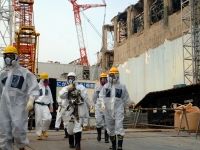Tokyo Electric Power Company Admits Fukushima Failures

Tokyo Electric Power Company (Tepco) is facing calls to be shut down for failing to properly manage the environmental catastrophe caused by the meltdown of three of the company's nuclear reactors in Fukushima, Japan. The disaster was the result of a tsunami triggered by a March 2011 earthquake.
Official inquiries have concluded that the situation was not the unexpected result of a natural phenomenon. "It was a profoundly manmade disaster - that could and should have been foreseen and prevented," wrote Kiyoshi Kurokawa, the chair of an independent commission appointed by the government, in an 88 page final report that was issued in July 2012.
"Our report catalogues a multitude of errors and wilful negligence that left the Fukushima plant unprepared for the events of March 11," he added. "And it examines serious deficiencies in the response to the accident by Tepco, regulators and the government."
This is not the first time that Tepco has had problems with nuclear safety. In 2002 the company admitted that it had covered up hundreds of problems dating back as early as 1977 - forcing three top Tepco officials to resign including the company president.
In 2007 an earthquake shut down the company's Kashiwazaki Kariwa nuclear plant Niigata prefecture, the largest in the world. None of the reactors melted down on that occasion but the company had to conduct extensive repairs causing the 62 year old company to run a significant financial loss.
None of this appears to have prepared the company to anticipate the Fukushima disaster, which forced the Japanese government to evacuate 160,000 people from the region around the plant.
Recently Tepco has finally started to admit that it made serious mistakes. "Our safety culture, skills and ability were all insufficient," Naomi Hirose, Tepco's president, told a news conference in April. "We must humbly accept our failure to
prevent the accident, which we should have avoided by using our wisdom
and human resources to be better prepared."
Even then the company flatly denied that the ground water that flooded the basements of the damaged reactor buildings has been leaking into the ocean, resulting in elevated levels of radioactive cesium and strontium that are dangerous to human health.
Last week the company acknowledged the groundwater contamination causing Shunichi Tanaka, the chair of the Japanese nuclear energy oversight body, to raise the danger rating of Fukushima from one to three on a zero to seven scale of the International Nuclear and Radiological Event Scale (INES).
Government officials say that they are very unhappy with Tepco. "We've allowed Tokyo Electric to deal with the contaminated water situation on its own and they've essentially turned it into a game of 'Whack-a-Mole,'" Toshimitsu Motegi, the Japanese trade minister, told reporters earlier this week. "From now on, the government will move to the forefront."
But other politicians have demanded even stronger measures. "I feel very insecure about the fact that a company that cannot learn from its past mistakes would operate a nuclear power plant," Hirohiko Izumida, governor of Niigata, told reporters. "There should be some procedures considered to bring about the liquidation of Tepco."
The company is already in severe financial difficulties, In May 2012, the company was forced to accept a one trillion yen ($12.5 billion) government bailout in exchange for 50.1 percent of its shares. (Not counting banks, the bail-out was the second largest in history after the U.S. rescue of General Motors in 2009) A month later, facing a major collapse in the company stock price, shareholders voted to effectively nationalize the company.
Now the total cost of clean up for the company is estimated at 11 trillion yen ($137 billion) almost as much as the value of the company which is valued at just over 14 trillion yen.
- 183 Environment



